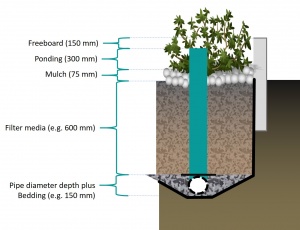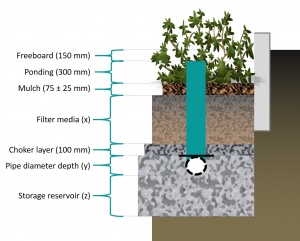Difference between revisions of "Planters: Sizing"
Jump to navigation
Jump to search
Jenny Hill (talk | contribs) (Created page with "thumb|A flow-through planter comprises a ponding zone, mulch layer, filter media for planting, and a supporting gravel drainage layer") |
Jenny Hill (talk | contribs) m |
||
| Line 1: | Line 1: | ||
[[File:Sizing flow-through planter.jpg|thumb|A flow-through planter comprises a ponding zone, mulch layer, filter media for planting, and a supporting gravel drainage layer]] | [[File:Sizing flow-through planter.jpg|thumb|A flow-through planter comprises a ponding zone, mulch layer, filter media for planting, and a supporting gravel drainage layer]] | ||
| + | This article is specific to [[bioretention]], vegetated systems that infiltrate water to the native soil. <br> | ||
| + | If you are designing a planted system which does not infiltrate water, see advice on [[Planters: Sizing]]. | ||
| + | [[File:Sizing Bioretention.jpg|thumb|The vertical storage zones in a bioretention cell include: ponding, mulch, filter media, choker course, pipe diameter reservoir and the storage reservoir.]] | ||
| + | {{TOClimit|2}} | ||
| + | Many of the dimensions in a bioretention system can be predetermined according to the function of the component. There is greatest flexibility in the ponding depth and the depth of the storage reservoir beneath the optional underdrain pipe. The order of operations in calculating these dimensions depends on whether an underdrain is desired. | ||
| + | |||
| + | {| class="wikitable" | ||
| + | |- | ||
| + | ! Component | ||
| + | ! Recommended depth (with underdrain pipe) | ||
| + | ! Recommended depth (no underdrain pipe) | ||
| + | ! Typical void ratio (''V<sub>R</sub>'') | ||
| + | |- | ||
| + | | Ponding (''d<sub>p</sub>'') | ||
| + | | 300 mm | ||
| + | | See below | ||
| + | | 1 | ||
| + | |- | ||
| + | | [[Mulch]] | ||
| + | | colspan="2" |75 ± 25 mm | ||
| + | | | ||
| + | * 0.7 for wood based | ||
| + | * 0.4 for aggregate | ||
| + | |- | ||
| + | | [[Bioretention: Filter media|filter media]] (''d<sub>m</sub>'') | ||
| + | | colspan="2" | | ||
| + | * 300 mm to support turf grass (and accept only rainwater/roof runoff) | ||
| + | * 600 mm to support flowering [[perennials]] and decorative [[grasses]] | ||
| + | * 1000 mm to support [[trees]] | ||
| + | | 0.3 | ||
| + | |- | ||
| + | | [[choker layer|Choker course]] | ||
| + | | colspan="2" |100 mm | ||
| + | | 0.4 typical | ||
| + | |- | ||
| + | | Pipe diameter reservoir | ||
| + | | Is equal to underdrain pipe diameter | ||
| + | | Not applicable | ||
| + | | 0.4 | ||
| + | |- | ||
| + | | Storage reservoir (''d<sub>s</sub>'') | ||
| + | | See below | ||
| + | | See below | ||
| + | | 0.4 | ||
| + | |} | ||
| + | |||
| + | |||
| + | ==Calculate the maximum overall depth== | ||
| + | *Step 1: Determine what the planting needs are and assign appropriate depth of media, using the table above. | ||
| + | *Step 2: Select an underdrain pipe diameter (typically 100 - 200 mm), assign this as an 'embedding' depth. | ||
| + | *Step 3: Calculate the maximum possible storage reservoir depth beneath the pipe (''d<sub>s</sub>''): | ||
| + | <math>d_{s}=f'\times38.4</math> | ||
| + | {{Plainlist|1=Where: | ||
| + | *''f''' = Design infiltration rate in mm/hr, and | ||
| + | *38.4 comes from multiplying desired drainage time of 96 hours by void ratio of 0.4}} | ||
| + | |||
| + | ===Additional step for system without underdrain=== | ||
| + | *Step 4: Determine maximum permissible ponding depth (''d<sub>p</sub>''): | ||
| + | <math>d_{p}=f'\times19.2</math> | ||
| + | {{Plainlist|1=Where: | ||
| + | *''f''' = Design infiltration rate in mm/hr, and | ||
| + | *19.2 comes from multiplying desired drainage time of 48 hours by void ratio of 0.4. Note that conceptually the drainage of the ponded area is limited by ex-filtration at the base of the practice.}} | ||
| + | * Step 5: Sum total depth of bioretention, and compare to available space above water table and bedrock. Adjust if necessary. | ||
| + | |||
| + | ==Calculate the remaining dimensions== | ||
| + | * Step 6: Multiply the depth of each separate component by the void ratio and then sum the total to find the 1 dimensional storage (in mm). | ||
| + | * Step 7: Calculate the required total storage (m<sup>3</sup>): | ||
| + | <math>Storage=RVC_T\times A_c\times C\times 0.1</math> | ||
| + | {{Plainlist|1=Where: | ||
| + | *''RVC<sub>T</sub>'' is the Runoff volume control target (mm), | ||
| + | *''A<sub>c</sub>'' is the catchment area (Ha), | ||
| + | *''C'' is the runoff coefficient of the catchment area, and | ||
| + | * 0.1 is the units correction between m<sup>3</sup> and mm.Ha.}} | ||
| + | * Step 8. Divide required storage (m<sup>3</sup>) by the 1 dimensional storage (in m) to find the required footprint area (''A<sub>p</sub>'') for the bioretention in m<sup>2</sup>. | ||
| + | * Step 9. Calculate the peak flow rate (''Q<sub>p</sub>'', in L/s) through the filter media: | ||
| + | ---- | ||
Revision as of 17:32, 19 March 2018
This article is specific to bioretention, vegetated systems that infiltrate water to the native soil.
If you are designing a planted system which does not infiltrate water, see advice on Planters: Sizing.
Many of the dimensions in a bioretention system can be predetermined according to the function of the component. There is greatest flexibility in the ponding depth and the depth of the storage reservoir beneath the optional underdrain pipe. The order of operations in calculating these dimensions depends on whether an underdrain is desired.
| Component | Recommended depth (with underdrain pipe) | Recommended depth (no underdrain pipe) | Typical void ratio (VR) |
|---|---|---|---|
| Ponding (dp) | 300 mm | See below | 1 |
| Mulch | 75 ± 25 mm |
| |
| filter media (dm) |
|
0.3 | |
| Choker course | 100 mm | 0.4 typical | |
| Pipe diameter reservoir | Is equal to underdrain pipe diameter | Not applicable | 0.4 |
| Storage reservoir (ds) | See below | See below | 0.4 |
Calculate the maximum overall depth[edit]
- Step 1: Determine what the planting needs are and assign appropriate depth of media, using the table above.
- Step 2: Select an underdrain pipe diameter (typically 100 - 200 mm), assign this as an 'embedding' depth.
- Step 3: Calculate the maximum possible storage reservoir depth beneath the pipe (ds):
Where:
- f' = Design infiltration rate in mm/hr, and
- 38.4 comes from multiplying desired drainage time of 96 hours by void ratio of 0.4
Additional step for system without underdrain[edit]
- Step 4: Determine maximum permissible ponding depth (dp):
Where:
- f' = Design infiltration rate in mm/hr, and
- 19.2 comes from multiplying desired drainage time of 48 hours by void ratio of 0.4. Note that conceptually the drainage of the ponded area is limited by ex-filtration at the base of the practice.
- Step 5: Sum total depth of bioretention, and compare to available space above water table and bedrock. Adjust if necessary.
Calculate the remaining dimensions[edit]
- Step 6: Multiply the depth of each separate component by the void ratio and then sum the total to find the 1 dimensional storage (in mm).
- Step 7: Calculate the required total storage (m3):
Where:
- RVCT is the Runoff volume control target (mm),
- Ac is the catchment area (Ha),
- C is the runoff coefficient of the catchment area, and
- 0.1 is the units correction between m3 and mm.Ha.
- Step 8. Divide required storage (m3) by the 1 dimensional storage (in m) to find the required footprint area (Ap) for the bioretention in m2.
- Step 9. Calculate the peak flow rate (Qp, in L/s) through the filter media:




